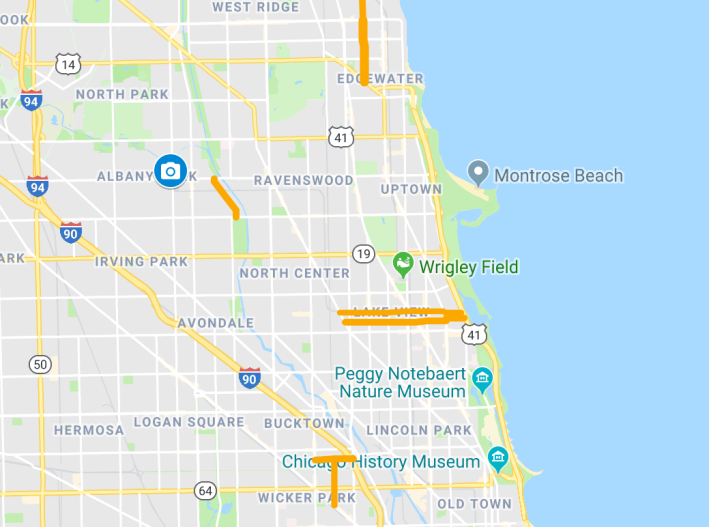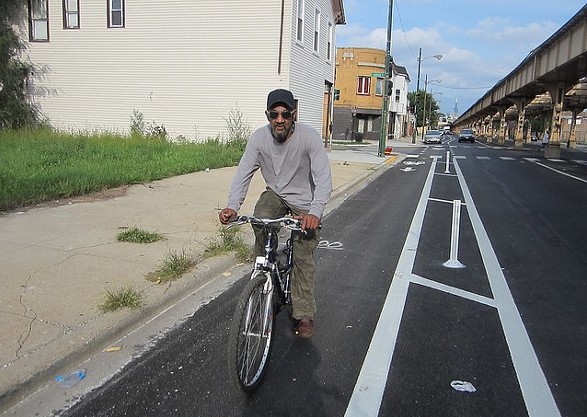Update 10/16/18: Active Trans announced yesterday that 27 local CEOs have sent a letter to Governor Bruce Rauner and gubernatorial challenger J.B. Pritzker asking them to commit to establishing a $50 million annual state Bike Walk Fund.
Last week I tweeted out before-and-after photos of a slip-lane removal at Roscoe/Paulina/Lincoln in the affluent, majority-white Lakeview neighborhood. By eliminating a channelized right turn for drivers, the city made crossing the street safer and easier for pedestrians, and created new public space.
"Lots of interesting projects in white neighborhoods," responded a reader.
He raised a good point. More often then not, when the Chicago Department of Transportation does an innovative project to create safer conditions for walking and/or biking, it happens in a largely white, relatively privileged part of town.
In this instance, the slip lane removal was funded as part of a project to repave Lincoln Avenue after a water main replacement ripped up the street. But in many cases forward-thinking transportation initiatives are paid for by ward menu funds. That was the situation with the recent Milwaukee Avenue complete streets makeover, and all of Chicago's neighborhood greenway side-street bike routes. Special Service Area money, raised via a tax on businesses within the SSA district, is another funding option.

But spending that discretionary cash on innovative projects takes political support from residents. That's relatively easy to come by in neighborhoods with plenty of folks who fit the stereotypical demographics of sustainable transportation advocates.
But in many South and West Side communities with high unemployment and crime rates, traffic safety may not be the top concern. Wards in these less-dense parts of town also cover more square-mileage than many North Side districts, which means menu money has to be spread over a wider area.
It's understandable that people on the South and West sides may be more interested in using all of their ward's $1.3 million in annual menu funds for meat-and-potato projects like repaving potholed streets, fixing crumbling sidewalks, or replacing broken streetlights, rather than, say, striping new bike lanes or building raised crosswalks. But that doesn't mean that residents in these parts of town don't also need and deserve safer, more convenient conditions for walking, biking, and transit use.
Fortunately the Active Transportation Alliance recently launched campaigns to help level the playing field by ensuring that all Chicago neighborhood have adequate funding for bike/ped projects. The group is calling on the next mayor and City Council to dedicate $20 million a year for a Bike Walk Fund. In addition to marquee initiatives like protected bike lanes and new pedestrian plazas, the money could also be used for basic infrastructure that's still more common in wealthier areas, such as well-lit crosswalks, countdown timers, and bus stop bump-outs.
Importantly, Active Trans is pushing for the Bike Walk Fund to be focused on high-crash corridors and underserved South and West Side communities. "Historically disinvested communities with the greatest barriers to biking and walking must be prioritized with any new money," they state. You can support the Chicago Bike Walk Fund proposal by signing their petition.
- Community and Neighborhood Improvement Project
- Garfield Park Community Council
- Greater Roseland Chamber of Commerce
- Grow Greater Englewood
- Major Taylor Cycling Club
- Northwest Side Housing Center
- Pilsen Alliance
- Coalition to Reduce Recidivism
These groups already have proposals for ways this new funding could be used to promote safety, mobility and health in their communities. For example, Grow Greater Englewood is pushing for the Englewood Line, a new rails-to-trails along an embankment between 58th and 59th Streets from Wallace to Hoyne avenues. The Community and Neighborhood Improvement Project wants to improve access to the Southwest Side's Major Taylor Trail. And the Northwest Side Housing Center is advocating for better bike routes in the Belmont Cragin neighborhood.
You can contact robert@activetrans.org if your community organization would like to get involved with the Bike Walk Fund campaigns.
Adequate citywide and statewide funding for bike and pedestrian safety would help ensure that good bike/ped projects don't just take place in Chicago neighborhoods that are already relatively good places to cycle and walk, but also the underserved communities that stand to gain the most from these improvements.
![]()
Did you appreciate this post? Consider making a donation through our PublicGood site.






